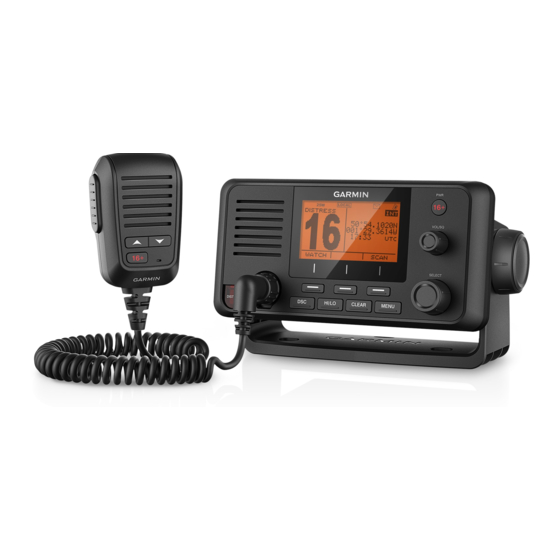- ページ 7
海上ラジオ Garmin VHF 115 AIS SeriesのPDF オーナーズマニュアルをオンラインで閲覧またはダウンロードできます。Garmin VHF 115 AIS Series 37 ページ。
Garmin VHF 115 AIS Series にも: 取付説明書 (4 ページ)

2
Select an option:
• To exclude the currently active channel from subsequent
passes and resume scanning, select SKIP.
• To scan channel 16 each time another saved channel is
scanned, select +CH16.
For example, the radio scans saved channel 21, channel
16, saved channel 25, channel 16, and so on.
+CH16 appears on the device screen.
• To stop scanning channel 16, select -CH16.
For example, the radio scans saved channel 21, saved
channel 25, and so on.
• To end the scan, select EXIT.
The radio stops scanning and tunes to the last used active
channel.
Monitoring Multiple Channels
Before you can monitor multiple channels, you must turn off
ATIS
(Automatic Transmitter Identification System, page
You can monitor priority channels and the currently selected
channel for broadcasting activity. Channel 16 is the first-priority
channel on your radio. Channel 9 is the default second-priority
channel. You can program a different channel as your second-
priority channel
(Selecting a Different Second-Priority Channel,
page
3).
Select WATCH.
Monitoring Two Channels
You can monitor your current channel and channel 16 at the
same time.
Select WATCH > DUAL.
DUAL WATCH and the channels you are monitoring appear
on the screen. For example, DUAL WATCH CH:, and 16 + 9.
Monitoring Three Channels
You can monitor your current channel, channel 16, and your
second-priority channel at the same time.
Select WATCH > TRI.
TRI WATCH, your current channel, channel 16, and your
second-priority channel appear on the screen. For example,
TRI WATCH CH:, and 75 + 16 + 9.
Selecting a Different Second-Priority
Channel
You can select a channel other than channel 9 as your second-
priority channel.
1
Select MENU > CHANNEL > 2ND PRIORITY.
2
Select an option:
• On the radio, turn the SELECT dial to the preferred
channel.
• On the handset, select
channel.
3
Select OK.
Switching to Priority Channels
You can quickly switch between your current working channel
and a priority channel. When you change to a priority channel,
the transmit power is set to high (25 W) automatically, and when
you change back to your current channel, the transmit-power
setting is restored.
On North American models, you can quickly switch between
channel 16, your second-priority channel, and your original
channel using the 16/9 key.
On International models, you can quickly switch between
channel 16 and your original channel using the 16+ key.
Basic Operation
9).
or
to find the preferred
1
To switch from your current channel to channel 16, select
16/9 or 16+.
The transmit power changes to high (25 W) automatically.
You can select HI/LO > 1W to change the transmit power to
low (1 W).
2
On North American models, select 16/9 to switch to your
second-priority channel.
3
Select 16/9 or 16+ to return to your previous channel and
transmit-power setting.
Setting the Receiving Sensitivity
You can control the receiving sensitivity of the radio. When you
have noise in high-traffic areas or areas with electromagnetic
interference, such as near cell-phone towers, you can set the
receiving sensitivity to LOC to decrease receiver sensitivity. In
remote areas and on open water, you can set the receiving
sensitivity to DIST to ensure that you use the maximum range of
the receiver.
1
Select HI/LO.
2
Select an option:
• Select LOC to enable local sensitivity.
• Select DIST to enable distant sensitivity.
Switching Between 1 W and 25 W
Transmitting Modes
You can control the transmitting power of the radio. Low (1 W) is
used for local transmissions, and high (25 W) is used for
distance and distress transmissions.
When two signals broadcast on the same frequency, a VHF
radio receives only the stronger of the two signals. You should
transmit calls other than distress calls using the lowest power
setting that allows you to communicate, to reduce the possibility
that your transmissions interfere with the transmissions of
others.
In the USA channel band, transmissions on channels 13, 17, 67,
and 77 must be low (1 W) by default.
In the Canadian channel band, transmissions on channels 13,
15, 17, 20, 1066, 67, 75, 76, and 77 must be low (1 W) by
default.
In the International channel band, transmissions on channels 15,
17, 75, and 76 must be low (1 W).
NOTE: In the USA and Canadian channel bands, you can
bypass the power setting for these channels temporarily during
transmission
(Bypassing the Low Transmission Power Setting,
page
2). In the International channel band, the radio does not
permit transmissions on these channels to be changed to high
(25 W).
1
Select HI/LO.
2
Select 1W or 25W.
3
Select OK.
Using the Hailer
Before you can use the hailer function, you must provide and
install a hailer horn on your boat deck or tower (optional). For
more information, see the VHF 115/215 AIS Series Installation
Instructions.
The hailer allows you to make on-boat or ship-to-shore
announcements, and allows two-way communications between
connected radios. You can address the ship using the radio or
handset, and sounds received through the horn can be heard
through the radio speaker. For vessels with enclosed cabins, the
hailer allows you to hear sounds from the deck.
NOTE: Hailer functionality is not available on all VHF radio
models.
3
